Page 413 of 542
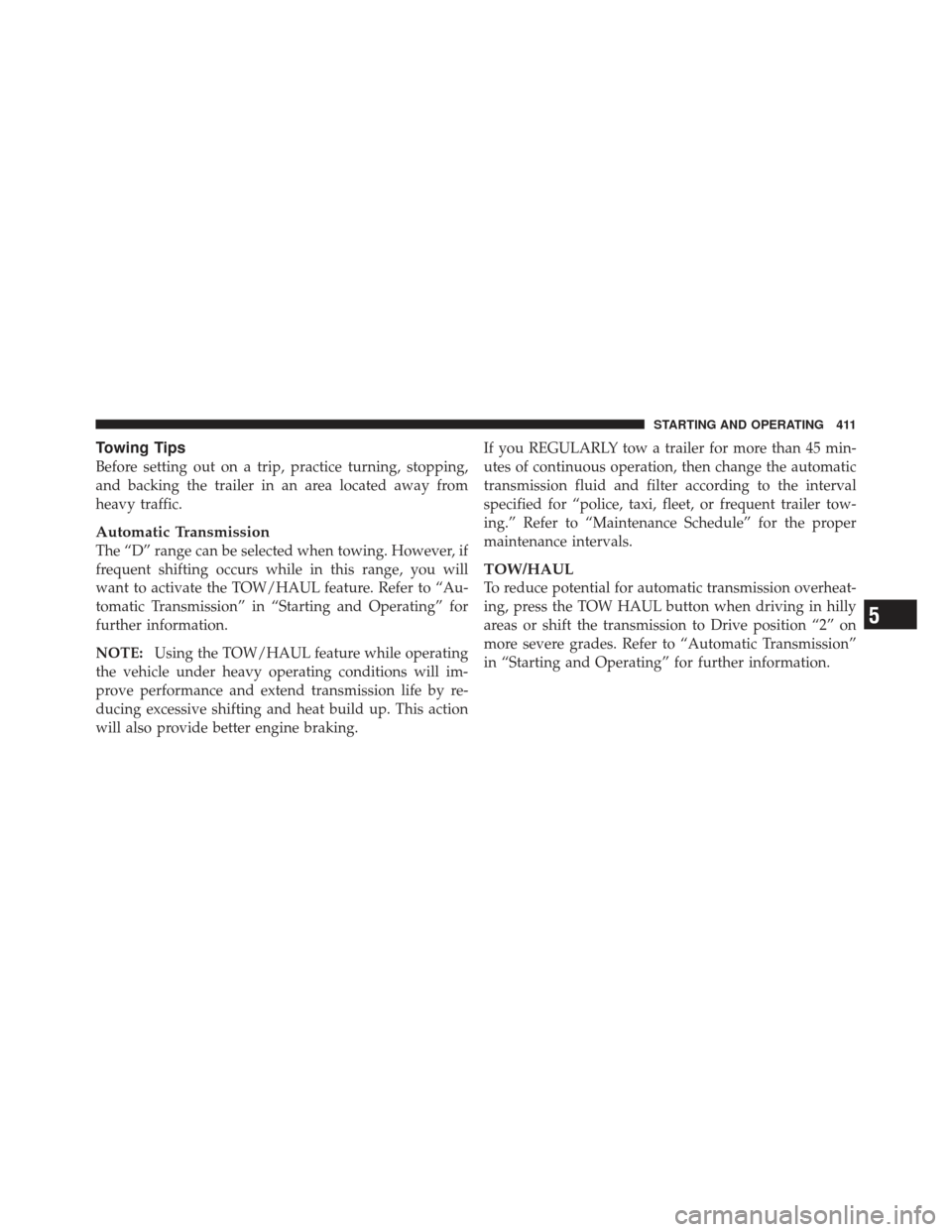
Towing Tips
Before setting out on a trip, practice turning, stopping,
and backing the trailer in an area located away from
heavy traffic.
Automatic Transmission
The “D” range can be selected when towing. However, if
frequent shifting occurs while in this range, you will
want to activate the TOW/HAUL feature. Refer to “Au-
tomatic Transmission” in “Starting and Operating” for
further information.
NOTE:Using the TOW/HAUL feature while operating
the vehicle under heavy operating conditions will im-
prove performance and extend transmission life by re-
ducing excessive shifting and heat build up. This action
will also provide better engine braking. If you REGULARLY tow a trailer for more than 45 min-
utes of continuous operation, then change the automatic
transmission fluid and filter according to the interval
specified for “police, taxi, fleet, or frequent trailer tow-
ing.” Refer to “Maintenance Schedule” for the proper
maintenance intervals.
TOW/HAUL
To reduce potential for automatic transmission overheat-
ing, press the TOW HAUL button when driving in hilly
areas or shift the transmission to Drive position “2” on
more severe grades. Refer to “Automatic Transmission”
in “Starting and Operating” for further information.
5
STARTING AND OPERATING 411
Page 415 of 542
RECREATIONAL TOWING (BEHIND MOTORHOME, ETC.)
Towing This Vehicle Behind Another Vehicle
Towing Condition Wheel OFF theGroundTwo-Wheel Drive
Models Four-Wheel Drive Models
Flat Tow NONENOT ALLOWED See Instructions
•Transmission in PARK
•Transfer case in NEUTRAL (N)
•Tow in forward direction
Dolly Tow Front
NOT ALLOWED NOT ALLOWED
Rear OK NOT ALLOWED
On Trailer ALLOK OK5
STARTING AND OPERATING 413
Page 416 of 542
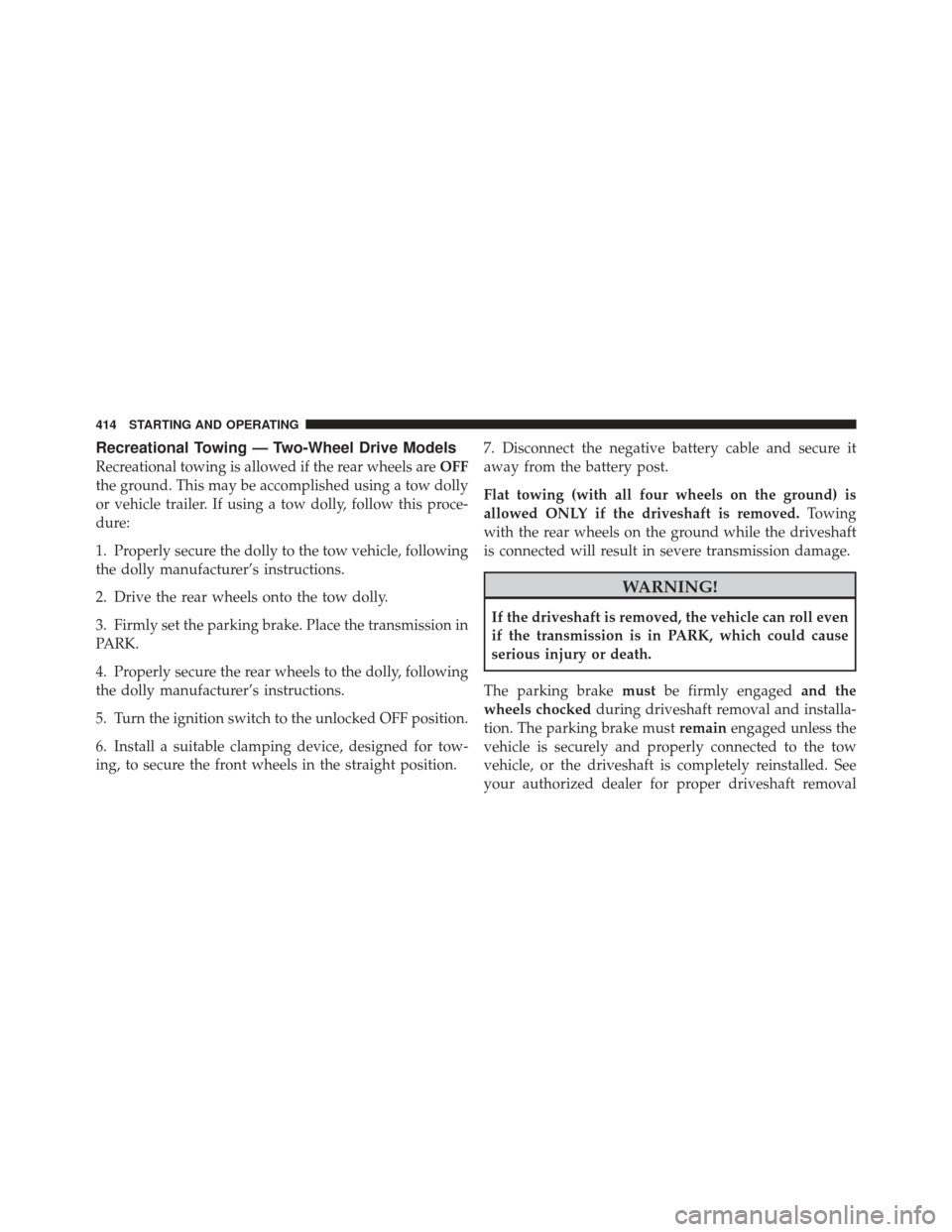
Recreational Towing — Two-Wheel Drive Models
Recreational towing is allowed if the rear wheels areOFF
the ground. This may be accomplished using a tow dolly
or vehicle trailer. If using a tow dolly, follow this proce-
dure:
1. Properly secure the dolly to the tow vehicle, following
the dolly manufacturer’s instructions.
2. Drive the rear wheels onto the tow dolly.
3. Firmly set the parking brake. Place the transmission in
PARK.
4. Properly secure the rear wheels to the dolly, following
the dolly manufacturer’s instructions.
5. Turn the ignition switch to the unlocked OFF position.
6. Install a suitable clamping device, designed for tow-
ing, to secure the front wheels in the straight position. 7. Disconnect the negative battery cable and secure it
away from the battery post.
Flat towing (with all four wheels on the ground) is
allowed ONLY if the driveshaft is removed.
Towing
with the rear wheels on the ground while the driveshaft
is connected will result in severe transmission damage.
WARNING!
If the driveshaft is removed, the vehicle can roll even
if the transmission is in PARK, which could cause
serious injury or death.
The parking brake mustbe firmly engaged and the
wheels chocked during driveshaft removal and installa-
tion. The parking brake must remainengaged unless the
vehicle is securely and properly connected to the tow
vehicle, or the driveshaft is completely reinstalled. See
your authorized dealer for proper driveshaft removal
414 STARTING AND OPERATING
Page 417 of 542
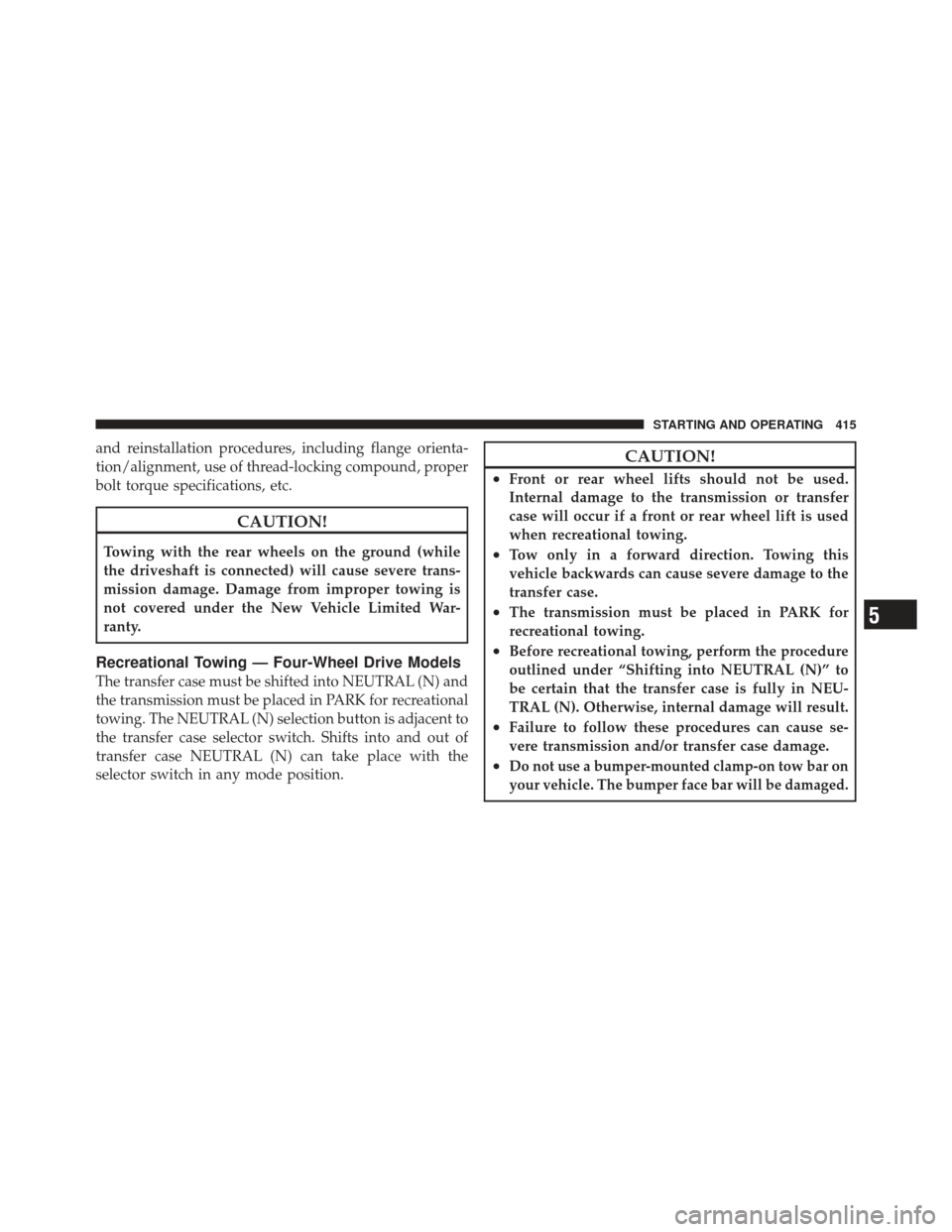
and reinstallation procedures, including flange orienta-
tion/alignment, use of thread-locking compound, proper
bolt torque specifications, etc.
CAUTION!
Towing with the rear wheels on the ground (while
the driveshaft is connected) will cause severe trans-
mission damage. Damage from improper towing is
not covered under the New Vehicle Limited War-
ranty.
Recreational Towing — Four-Wheel Drive Models
The transfer case must be shifted into NEUTRAL (N) and
the transmission must be placed in PARK for recreational
towing. The NEUTRAL (N) selection button is adjacent to
the transfer case selector switch. Shifts into and out of
transfer case NEUTRAL (N) can take place with the
selector switch in any mode position.
CAUTION!
•Front or rear wheel lifts should not be used.
Internal damage to the transmission or transfer
case will occur if a front or rear wheel lift is used
when recreational towing.
•Tow only in a forward direction. Towing this
vehicle backwards can cause severe damage to the
transfer case.
•The transmission must be placed in PARK for
recreational towing.
•Before recreational towing, perform the procedure
outlined under “Shifting into NEUTRAL (N)” to
be certain that the transfer case is fully in NEU-
TRAL (N). Otherwise, internal damage will result.
•Failure to follow these procedures can cause se-
vere transmission and/or transfer case damage.
•Do not use a bumper-mounted clamp-on tow bar on
your vehicle. The bumper face bar will be damaged.
5
STARTING AND OPERATING 415
Page 418 of 542
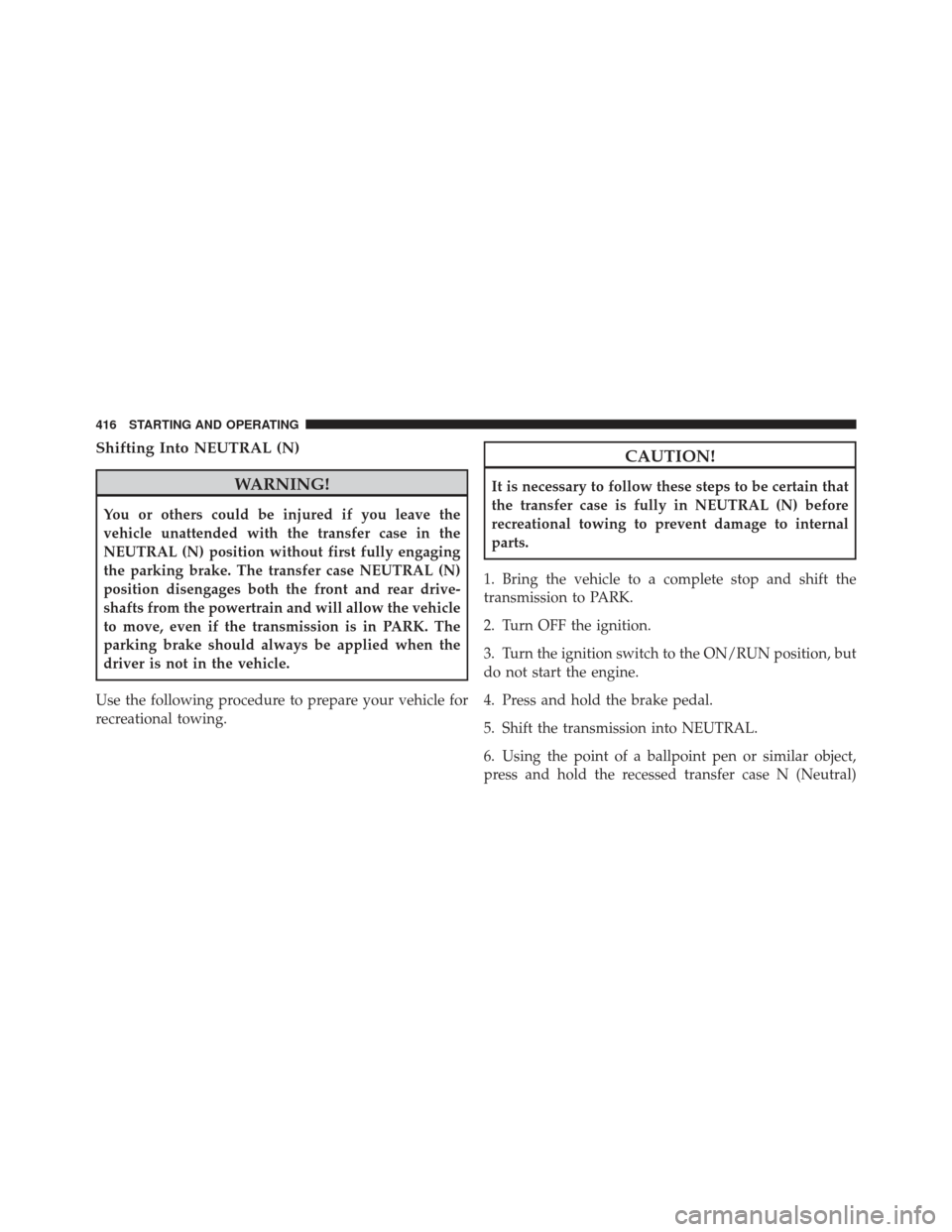
Shifting Into NEUTRAL (N)
WARNING!
You or others could be injured if you leave the
vehicle unattended with the transfer case in the
NEUTRAL (N) position without first fully engaging
the parking brake. The transfer case NEUTRAL (N)
position disengages both the front and rear drive-
shafts from the powertrain and will allow the vehicle
to move, even if the transmission is in PARK. The
parking brake should always be applied when the
driver is not in the vehicle.
Use the following procedure to prepare your vehicle for
recreational towing.
CAUTION!
It is necessary to follow these steps to be certain that
the transfer case is fully in NEUTRAL (N) before
recreational towing to prevent damage to internal
parts.
1. Bring the vehicle to a complete stop and shift the
transmission to PARK.
2. Turn OFF the ignition.
3. Turn the ignition switch to the ON/RUN position, but
do not start the engine.
4. Press and hold the brake pedal.
5. Shift the transmission into NEUTRAL.
6. Using the point of a ballpoint pen or similar object,
press and hold the recessed transfer case N (Neutral)
416 STARTING AND OPERATING
Page 420 of 542
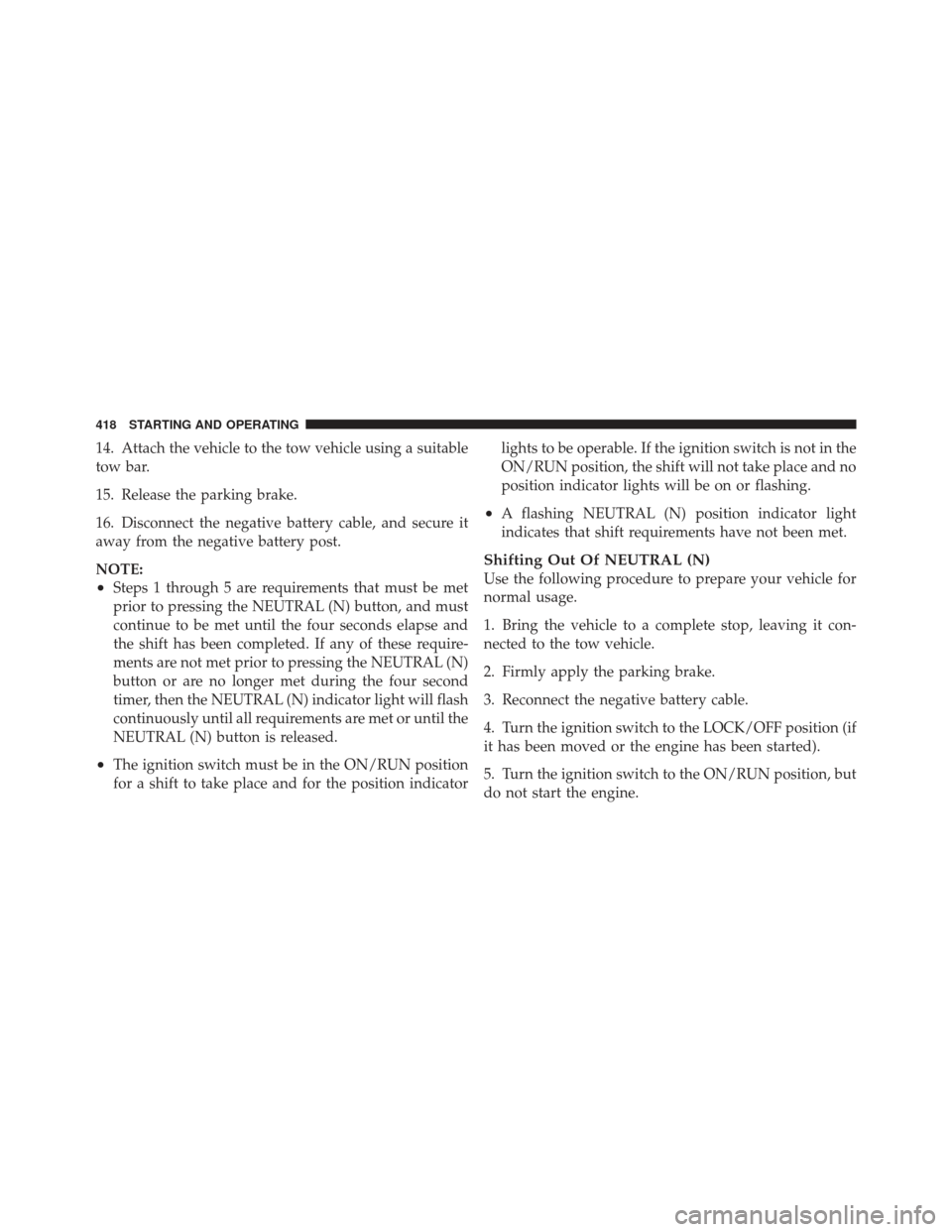
14. Attach the vehicle to the tow vehicle using a suitable
tow bar.
15. Release the parking brake.
16. Disconnect the negative battery cable, and secure it
away from the negative battery post.
NOTE:
•Steps 1 through 5 are requirements that must be met
prior to pressing the NEUTRAL (N) button, and must
continue to be met until the four seconds elapse and
the shift has been completed. If any of these require-
ments are not met prior to pressing the NEUTRAL (N)
button or are no longer met during the four second
timer, then the NEUTRAL (N) indicator light will flash
continuously until all requirements are met or until the
NEUTRAL (N) button is released.
•The ignition switch must be in the ON/RUN position
for a shift to take place and for the position indicatorlights to be operable. If the ignition switch is not in the
ON/RUN position, the shift will not take place and no
position indicator lights will be on or flashing.
•A flashing NEUTRAL (N) position indicator light
indicates that shift requirements have not been met.
Shifting Out Of NEUTRAL (N)
Use the following procedure to prepare your vehicle for
normal usage.
1. Bring the vehicle to a complete stop, leaving it con-
nected to the tow vehicle.
2. Firmly apply the parking brake.
3. Reconnect the negative battery cable.
4. Turn the ignition switch to the LOCK/OFF position (if
it has been moved or the engine has been started).
5. Turn the ignition switch to the ON/RUN position, but
do not start the engine.
418 STARTING AND OPERATING
Page 421 of 542
6. Press and hold the brake pedal.
7. Shift the transmission into NEUTRAL.
8. Using the point of a ballpoint pen or similar object,
press and hold the recessed transfer case N (Neutral)
button (located above the selector switch) for one second.9. After the N (Neutral) indicator light turns off, release
the N (Neutral) button.
10. After the N (Neutral) button has been released, the
transfer case will shift to the position indicated by the
selector switch.
NOTE:
When shifting out of transfer case N (Neutral),
turning the engine OFF may be required to avoid gear
clash.
11. Shift the transmission into PARK.
12. Release the brake pedal.
13. Disconnect vehicle from the tow vehicle.
14. Start the engine.
15. Press and hold the brake pedal.
16. Release the parking brake.
Neutral Switch
5
STARTING AND OPERATING 419
Page 423 of 542
WHAT TO DO IN EMERGENCIES
CONTENTS
�Hazard Warning Flashers ................ 422
� If Your Engine Overheats ................ 422
� Jacking And Tire Changing ............... 423
▫ Jack Location ....................... 424
▫ Spare Tire Stowage ................... 424
▫ Spare Tire Removal ................... 425
▫ Preparations For Jacking ............... 426
▫ Jacking Instructions ................... 426 �
Jump-Starting Procedures ................ 430
▫ Preparations For Jump-Start ............. 430
▫ Jump-Starting Procedure ............... 432
� Freeing A Stuck Vehicle ................. 434
� Shift Lever Override ................... 435
� Towing A Disabled Vehicle ............... 436
▫ Towing Without The Ignition Key FOB ..... 438
▫ Two-Wheel Drive Models .............. 438
▫ Four-Wheel Drive Models .............. 440
6